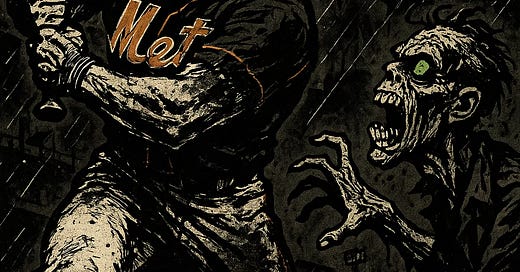Pete Alonso’s start to the 2025 season feels like a haymaker swung at one of baseball’s most persistent zombie myths: the idea that players sign massive contracts and then coast. You know the story — a player gets paid and, supposedly, the drive disappears, the performance dips, and the hunger fades.
It’s a theory that Dayn Perry actually dismantled almost twenty years ago in Baseball Between the Numbers, where he wrote: “The data doesn’t support the popular notion that players ‘dog it’ after signing a lucrative contract. Players generally continue along their established career trajectories, independent of their contract status.”
That was in 2006. Back when “advanced metrics” still sounded exotic and you couldn’t track a player’s launch angle from your seat behind home plate. Today, we have exponentially more data, more tools, more real-time information than Perry did then and yet, the myth refuses to die.
If you’re looking for evidence that it should, look no further than Alonso. Through April, he’s hitting almost 100 points better than he did last year. He’s just a shade behind Aaron Judge and Fernando Tatis Jr. in WAR, despite playing a defensively limited position that generally suppresses those totals. His approach is sharper. His two-strike hitting is better. Even his defense, long the “yeah, but” of his profile, has been good enough not to drag him down.
Alonso didn’t sign his contract and disappear. He signed it and doubled down on being great.
It’s not that fans don’t have access to better information now — it’s that the information isn’t evenly distributed. Ask 100 people at a ballgame what WAR is, and you might get 10 who know. Maybe 15, if you’re sitting near a college kid in a Fangraphs hat. Recently a friend texted me from Steinbrenner Field and asked me what X and Z were on the scoreboard. I didn’t know any places were doing pitch movement in real time. I’m old enough to remember when not every stadium had a radar gun reading!
And that’s fine.
It’s fine to come to the park, sit in the sun, drink a cold beer, and not overanalyze what you’re watching. Baseball needs that too. It’s part of the magic — the ability to be both the most casually enjoyable and the most deeply intricate sport, depending on what you’re looking for.
But it’s not okay to be wrong.
It’s not okay to keep parroting myths that have been disproven just because they fit an easy story arc. Even in a culture that too often embraces “alternative facts,” the truth still matters and in baseball, as in life, ideas deserve better marketing than myths.
Pete Alonso is marketing reality the old-fashioned way: by producing. By hitting. By working. He’s not a Bunyanesque figure like Judge or a style icon like Tatis. He’s the guy who shows up, who gets better, and who shrugs at the idea that effort is negotiable once the ink dries.
The reason myths like “players coast after getting paid” survive isn’t because they’re true — it’s because they appeal to a certain cynicism we like to believe about people. That money ruins everything. That success spoils drive. That once you get what you want, you let your guard down.
Sometimes, the real story is better.
Sometimes, a player signs a big contract and treats it like the first page of a new chapter instead of the closing line of an old one. Pete Alonso’s 2025 isn’t about complacency. It’s about what happens when belief, preparation, and talent align, and a player keeps pushing even after he has every excuse not to.
Facts matter. Pete Alonso is a fact.
So let’s get to the injuries:
LOGAN GILBERT, SP SEA (strained elbow)
It could be worse, Seattle. Logan Gilbert hits the IL with a Grade I flexor strain. It’s very mild and he was likely given an injection to help with the healing, which is pretty standard even with very mixed research on efficacy. The strain is pretty easy to visualize, so they should be able to monitor it and know when it’s safe to begin throwing again. However, it might be sooner than you think.
There’s some current theory that since we know that stress doesn’t transfer into the ligaments until about 60-70 percent effort, a lower effort throwing could help keep workload up without stressing the healing tendon. Tendons are a bit tougher because the muscle is working and moving, but it’s knowable with current tools. Doing it at lower levels with BFR? That might be the move we see soon, but probably not here. Just mentioning it, M’s fans.
The timeline on Gilbert is a bit mixed. If they can keep his arm loaded somewhat, the ramp is quicker and they could steal a start. This depends on the healing and just how conservative they want to be, which could depend on how the slot is held. I haven’t seen who the next starter in will be, but they have two off days this week before getting back to him. Luis F. Castillo could get the call again, or Jhonathan Diaz, but Logan Evans is another possibility after a good start at Tacoma.
Subscribers get to see past the paywall. Lots of good stuff back there today.





